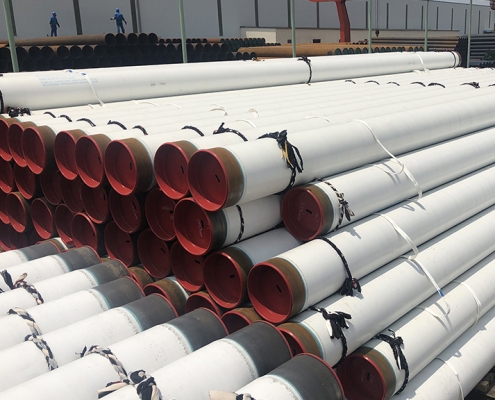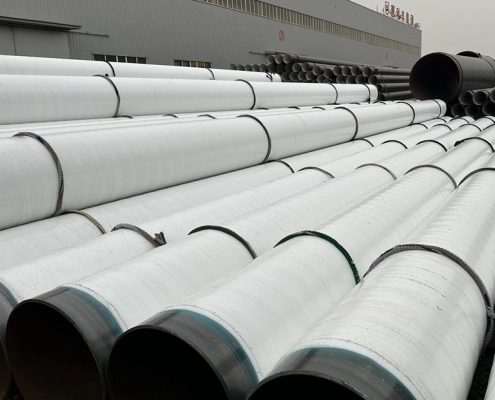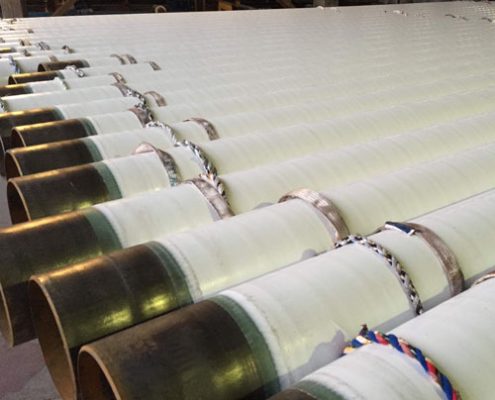Future Energy Steel specializes in manufacturing 3LPP Coated Pipe, adhering to DIN 30678, NF A49-721-1 or ISO 21809-1. 3LPP also called Three-Layer Polypropylene, offers superior corrosion resistance and durability, ideal for oil, gas, and water pipelines. The three-layer coating system consists of an epoxy primer, an adhesive layer, and a high-density polypropylene outer layer. This coating ensures excellent mechanical protection and UV resistance, suitable for harsh environments. It is extensively used in onshore and offshore pipelines, potable water systems, and industrial applications. The 3LPP coating significantly extends the pipe’s service life, making it a cost-effective solution for various infrastructure projects. If you need any corrosion protection support, please contact us at [email protected].
FAQs
What is 3LPP Coated Pipe?
3LPP (Three-Layer Polypropylene) coated pipe is a type of pipe designed to enhance durability and resistance in challenging environments. The coating consists of three distinct layers:
- Epoxy Primer: The first layer is an epoxy primer that provides excellent adhesion to the pipe’s surface and serves as a protective barrier against corrosion.
- Polypropylene Adhesive Layer: The second layer is a polypropylene adhesive that bonds the epoxy primer to the final outer layer, ensuring a strong and stable adhesion.
- Polypropylene Outer Layer: The third layer is a high-density polypropylene (PP) that offers superior mechanical protection and resistance to environmental and chemical factors.
This multi-layer coating system is engineered to improve the performance and lifespan of pipes, particularly in harsh or corrosive environments.
What Are the Advantages of 3LPP Coated Pipe?
3LPP coated pipes offer several significant benefits:
- Enhanced Corrosion Resistance: The epoxy primer and polypropylene layers work together to provide exceptional resistance to corrosion, extending the life of the pipe.
- Superior Mechanical Protection: The outer polypropylene layer provides excellent resistance to impact, abrasion, and mechanical damage, ensuring the pipe’s integrity during handling and operation.
- Chemical Resistance: The coating system is resistant to a wide range of chemicals, making it suitable for transporting various substances, including aggressive chemicals.
- High Temperature Resistance: Polypropylene has a higher temperature tolerance compared to some other coatings, which enhances the pipe’s performance in high-temperature applications.
- Low Maintenance: The durability of the coating reduces the need for frequent maintenance, leading to cost savings over the pipe’s lifespan.
What Are the Applications of 3LPP Coated Pipe?
3LPP coated pipes are used in various demanding applications due to their durability and protective features. Common applications include:
- Oil and Gas Pipelines: For transporting crude oil, natural gas, and other hydrocarbons, especially in environments prone to corrosion and mechanical stress.
- Chemical Transport: Suitable for pipelines that carry chemicals and other corrosive materials, where resistance to chemical attack is crucial.
- Water and Wastewater Systems: Used in municipal and industrial water and wastewater systems where corrosion and environmental factors pose challenges.
- Industrial Applications: In industrial settings where pipelines are exposed to harsh conditions and require robust protection.
- Infrastructure Projects: For use in construction and civil engineering projects, including underground and above-ground installations.
What is the Working Temperature Range of 3LPP Coated Pipe?
The working temperature range of 3LPP coated pipes generally spans from approximately -20°C to +110°C (-4°F to 230°F). However, the exact temperature range can vary depending on the specific formulation of the coating and the manufacturer’s recommendations. For precise temperature limits and performance characteristics, it is essential to refer to the product data sheet or consult with the manufacturer.
Related Standard Specifications for 3LPE and 3LPP Coatings
CSA Z245.21 External Polyethylene Coating for Pipe
DIN 30670-1 Polyethylene Coatings of Steel Pipes and Fittings – Part 1: Requirements and Testings of Factory-Applied Extruded Coatings
SHELL DEP 31.40.30.31-Gen. External Polyethylene and Polypropylene Coating for Line Pipe (Amendments/Supplements to ISO 21809-1)
BP GIS 06-403 Application of Three-Layer Fusion Bonded Epoxy-Polyethylene Coating and Three-Layer Polypropylene Coating System for Line Pipe
DNV-RP-F106 Factory Applied External Pipeline Coatings for Corrosion Control
ISO 21809-1 Petroleum and Natural Gas Industries — External Coatings for Buried or Submerged Pipelines Used in Pipeline Transportation Systems – Part 1: Polyolefin coatings (3-layer PE and 3-layer PP)
IPS-G-TP-335 Material and Construction Standard for Three-Layer Polyethylene Coating System
DIN30678 Polypropylene Coatings of Steel Pipes and Fittings – Part 1: Requirements and Testings of Factory-Applied Extruded Coatings
EN 10286 Steel Tubes and Fittings for Onshore and Offshore Pipelines –External Three-layer Extruded Polypropylene Based Coatings.
09-SAMSS-114 Shop-Applied Extruded, Three-Layer Polypropylene External Coatings for Line Pipe
NF A49-721-1 Petroleum and Natural Gas Industries – External Coatings for Buried or Submerged Pipelines Used in Pipeline Transportation Systems – Part 1: Polyolefin Coatings (3-Layer PE and 3-Layer PP)




